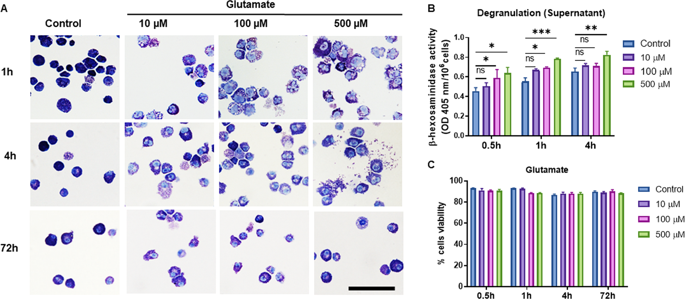当前位置:
X-MOL 学术
›
Cell. Mol. Immunol.
›
论文详情
Our official English website, www.x-mol.net, welcomes your
feedback! (Note: you will need to create a separate account there.)
Glutamate triggers the expression of functional ionotropic and metabotropic glutamate receptors in mast cells.
Cellular & Molecular Immunology ( IF 21.8 ) Pub Date : 2020-04-20 , DOI: 10.1038/s41423-020-0421-z Md Abdul Alim 1, 2 , Mirjana Grujic 2 , Paul W Ackerman 3 , Per Kristiansson 1 , Pernilla Eliasson 4 , Magnus Peterson 1, 5 , Gunnar Pejler 2, 6
Cellular & Molecular Immunology ( IF 21.8 ) Pub Date : 2020-04-20 , DOI: 10.1038/s41423-020-0421-z Md Abdul Alim 1, 2 , Mirjana Grujic 2 , Paul W Ackerman 3 , Per Kristiansson 1 , Pernilla Eliasson 4 , Magnus Peterson 1, 5 , Gunnar Pejler 2, 6
Affiliation

|
Mast cells are emerging as players in the communication between peripheral nerve endings and cells of the immune system. However, it is not clear the mechanism by which mast cells communicate with peripheral nerves. We previously found that mast cells located within healing tendons can express glutamate receptors, raising the possibility that mast cells may be sensitive to glutamate signaling. To evaluate this hypothesis, we stimulated primary mast cells with glutamate and showed that glutamate induced the profound upregulation of a panel of glutamate receptors of both the ionotropic type (NMDAR1, NMDAR2A, and NMDAR2B) and the metabotropic type (mGluR2 and mGluR7) at both the mRNA and protein levels. The binding of glutamate to glutamate receptors on the mast cell surface was confirmed. Further, glutamate had extensive effects on gene expression in the mast cells, including the upregulation of pro-inflammatory components such as IL-6 and CCL2. Glutamate also induced the upregulation of transcription factors, including Egr2, Egr3 and, in particular, FosB. The extensive induction of FosB was confirmed by immunofluorescence assessment. Glutamate receptor antagonists abrogated the responses of the mast cells to glutamate, supporting the supposition of a functional glutamate-glutamate receptor axis in mast cells. Finally, we provide in vivo evidence supporting a functional glutamate-glutamate receptor axis in the mast cells of injured tendons. Together, these findings establish glutamate as an effector of mast cell function, thereby introducing a novel principle for how cells in the immune system can communicate with nerve cells.
中文翻译:

谷氨酸触发肥大细胞中功能性离子型和代谢型谷氨酸受体的表达。
肥大细胞正在成为周围神经末梢和免疫系统细胞之间交流的参与者。然而,目前尚不清楚肥大细胞与周围神经交流的机制。我们之前发现位于愈合肌腱内的肥大细胞可以表达谷氨酸受体,这增加了肥大细胞可能对谷氨酸信号敏感的可能性。为了评估这一假设,我们用谷氨酸刺激原代肥大细胞,结果表明谷氨酸诱导了一组离子型(NMDAR1、NMDAR2A 和 NMDAR2B)和代谢型(mGluR2 和 mGluR7)谷氨酸受体的显着上调。 mRNA和蛋白质水平。证实了谷氨酸与肥大细胞表面上的谷氨酸受体的结合。进一步,谷氨酸对肥大细胞中的基因表达具有广泛的影响,包括促炎成分如 IL-6 和 CCL2 的上调。谷氨酸还诱导转录因子的上调,包括 Egr2、Egr3,特别是 FosB。通过免疫荧光评估证实了 FosB 的广泛诱导。谷氨酸受体拮抗剂消除了肥大细胞对谷氨酸的反应,支持了肥大细胞中功能性谷氨酸-谷氨酸受体轴的假设。最后,我们提供了支持受损肌腱肥大细胞中功能性谷氨酸-谷氨酸受体轴的体内证据。总之,这些发现确立了谷氨酸作为肥大细胞功能的效应物,从而为免疫系统中的细胞如何与神经细胞进行交流引入了一个新原理。
更新日期:2020-04-24
中文翻译:

谷氨酸触发肥大细胞中功能性离子型和代谢型谷氨酸受体的表达。
肥大细胞正在成为周围神经末梢和免疫系统细胞之间交流的参与者。然而,目前尚不清楚肥大细胞与周围神经交流的机制。我们之前发现位于愈合肌腱内的肥大细胞可以表达谷氨酸受体,这增加了肥大细胞可能对谷氨酸信号敏感的可能性。为了评估这一假设,我们用谷氨酸刺激原代肥大细胞,结果表明谷氨酸诱导了一组离子型(NMDAR1、NMDAR2A 和 NMDAR2B)和代谢型(mGluR2 和 mGluR7)谷氨酸受体的显着上调。 mRNA和蛋白质水平。证实了谷氨酸与肥大细胞表面上的谷氨酸受体的结合。进一步,谷氨酸对肥大细胞中的基因表达具有广泛的影响,包括促炎成分如 IL-6 和 CCL2 的上调。谷氨酸还诱导转录因子的上调,包括 Egr2、Egr3,特别是 FosB。通过免疫荧光评估证实了 FosB 的广泛诱导。谷氨酸受体拮抗剂消除了肥大细胞对谷氨酸的反应,支持了肥大细胞中功能性谷氨酸-谷氨酸受体轴的假设。最后,我们提供了支持受损肌腱肥大细胞中功能性谷氨酸-谷氨酸受体轴的体内证据。总之,这些发现确立了谷氨酸作为肥大细胞功能的效应物,从而为免疫系统中的细胞如何与神经细胞进行交流引入了一个新原理。











































 京公网安备 11010802027423号
京公网安备 11010802027423号